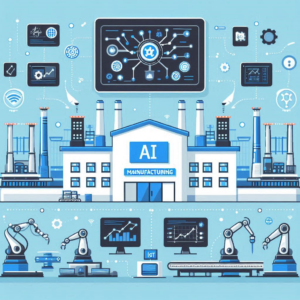
Introduction
The manufacturing industry is evolving rapidly with the rise of smart factories. Traditional mass production methods are struggling to keep up with modern demands for customization and efficiency. Consumers now expect personalized products, leading to the rise of AI-driven customized manufacturing. This approach enhances flexibility, improves resource utilization, and minimizes waste while addressing challenges like quality control and production optimization.
By integrating AI and smart factories, manufacturers can create intelligent systems capable of self-optimization, real-time decision-making, and dynamic resource allocation. This shift is transforming traditional factories into agile and responsive manufacturing hubs.
1. The Role of AI in Smart Factories
AI technologies are the backbone of smart factories, enabling seamless automation, predictive maintenance, and adaptive production. Key applications include:
Interconnectivity in Manufacturing
Smart factories utilize interconnected sensors, machines, and networks to enable real-time data exchange. This connectivity enhances manufacturing intelligence, ensuring smooth operations.
AI-Enabled Dynamic Resource Scheduling
AI algorithms in smart factories analyze demand fluctuations and optimize resource allocation. This adaptability enables rapid response to changing customer requirements.
Predictive Maintenance for Efficiency
AI-driven predictive maintenance helps detect potential equipment failures in advance. By minimizing downtime, smart factories improve efficiency and reduce maintenance costs.
AI-Optimized Supply Chains
AI enhances supply chain management by predicting demand, optimizing inventory, and ensuring a seamless flow of materials. It leverage this to reduce delays and improve production timelines.
Intelligent Fault Diagnosis
AI-powered diagnostic tools help identify and resolve manufacturing issues in real-time. This enhances product quality and prevents production disruptions.
2. Edge Intelligence
Edge computing plays a crucial role in AI-driven smart factories by processing data closer to the source, reducing latency, and improving system responsiveness. Key advantages include:
Real-Time Data Processing
Edge computing enables it to process data instantly, facilitating faster decision-making and operational efficiency.
Optimized Resource Utilization
By managing resources locally, edge intelligence ensures that machines and personnel are used efficiently, reducing wastage.
Enhanced Security Measures
With local data processing, It reduce the risks associated with cloud storage, enhancing data privacy and security.
Scalability in Smart Manufacturing
It powered by edge intelligence can scale effortlessly, accommodating new devices and production capabilities.
3. Implementing AI-Driven Customized Manufacturing
The transition to AI-driven customized manufacturing follows several critical steps:
Designing a Smart Factory System Architecture
A robust architecture integrates IoT devices, edge computing, AI-driven cloud services, and user-friendly interfaces.
Data Collection and AI Analysis
Sensors and IoT devices gather vast amounts of data, which AI algorithms analyze to optimize production.
AI-Based Task Allocation
Production tasks are broken down into smaller units and assigned to appropriate resources using AI-based scheduling.
Collaborative AI Systems
Multi-agent AI systems coordinate different parts of the smart factory, ensuring seamless production.
Continuous Optimization and Learning
AI-driven smart factories continuously learn from past data to refine processes, increasing efficiency over time.
4. Case Study: Smart Factory Candy Packaging Line
One example of AI-driven customized manufacturing is in the candy packaging industry. A personalized candy production system showcases AI’s impact on smart factories.
Personalized Customer Orders
A mobile application allows customers to customize candy flavors, colors, and packaging.
Cloud-Based Order Processing
Customer preferences are processed in the cloud and converted into production tasks.
Real-Time Edge Computing for Process Optimization
Edge computing ensures real-time adjustments to align production with customer requirements.
AI-Driven Resource Allocation
AI dynamically schedules production tasks based on real-time demand and machine availability.
Smart Quality Control
AI-powered quality control systems detect defects, ensuring that only high-quality products are packaged.
5. Challenges in AI-Driven Smart Factories
Despite the advantages of smart factories, several challenges remain:
Data Privacy and Cybersecurity Risks
Handling large volumes of sensitive data requires strong security protocols to prevent breaches.
Complexity of AI Integration
Integrating AI with existing manufacturing systems can be complex, requiring careful planning and execution.
Workforce Training and Skill Gaps
Manufacturers must invest in workforce training to bridge the skill gap in AI-driven production.
Scaling AI-Driven
Maintaining efficiency as smart factories expand requires advanced system designs that support scalability.
Conclusion
The rise of AI-driven customized manufacturing is reshaping the future of smart factories. By integrating AI with real-time decision-making and edge intelligence, manufacturers can achieve flexible, efficient, and adaptive production systems. not only improve productivity but also enhance customer satisfaction by delivering highly customized products.
As industries navigate AI adoption, focusing on continuous improvement and innovation will be key to success. The future belongs to businesses that embrace AI-driven smart factories, ensuring sustainability and competitiveness in a rapidly evolving manufacturing landscape.
Do you like to read more educational content? Read our blogs at Cloudastra Technologies or contact us for business enquiry at Cloudastra Contact Us.